Carbocation rearrangement - Study guides, Class notes & Summaries
Looking for the best study guides, study notes and summaries about Carbocation rearrangement? On this page you'll find 29 study documents about Carbocation rearrangement.
All 29 results
Sort by
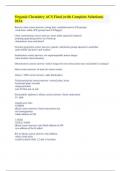 Popular
Popular
-
Organic Chemistry ACS Final (with Complete Solutions) 2024.
- Exam (elaborations) • 5 pages • 2024
- Available in package deal
-
- $10.19
- 3x sold
- + learn more
Basicity rules correct answers -strong base: unstable/reactive (ED groups) -weak base: stable (EW groups/more EN/bigger) Chair conformation correct answers -more stable equitorial (slanted) -pointing up/pointing down=cis if both up -elimination: trans and diaxial Newman projection correct answers -gauche: substituent groups adjacent to eachother -grab middle and turn to put in plane Enantiomers correct answers -not superimposable mirror images -same besides stereochemistry Diast...
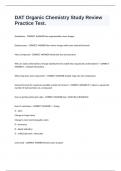
-
DAT Organic Chemistry Study Review Practice Test.
- Exam (elaborations) • 21 pages • 2024
-
- $12.99
- + learn more
DAT Organic Chemistry Study Review Practice Test. Enantiomer - CORRECT ANSWER Non-superposable mirror images Diastereomer - CORRECT ANSWER Non-mirror images with same chemical formula Meso Compound - CORRECT ANSWER Achiral but has stereocenters Why are axial conformations of large substituents less stable than equatorial conformations? - CORRECT ANSWER 1, 3 diaxial interactions What rings have more ring strain? - CORRECT ANSWER Smaller rings, but not cyclohexane General formu...
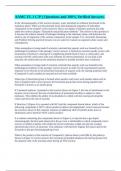
-
AAMC FL 1 C/P || Questions and 100% Verified Answers.
- Exam (elaborations) • 9 pages • 2024
-
- $11.19
- + learn more
In the chromatography of the reaction mixture, water absorbed on cellulose functioned as the stationary phase. What was the principal factor determining the migration of individual components in the sample? correct answers This is an Organic Chemistry question that falls under the content category "Separation and purification methods." The answer to this question is A because the relative amount of hydrogen bonding to the stationary phase will determine the relative rate of migration of the va...
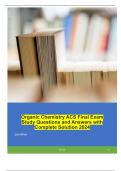
-
Organic Chemistry ACS Final Exam Study Questions and Answers with Complete Solution 2024
- Exam (elaborations) • 6 pages • 2024
- Available in package deal
-
- $13.49
- + learn more
Basicity rules - -strong base: unstable/reactive (ED groups) -weak base: stable (EW groups/more EN/bigger) Chair conformation - -more stable equitorial (slanted) -pointing up/pointing down=cis if both up -elimination: trans and diaxial Newman projection - -gauche: substituent groups adjacent to eachother -grab middle and turn to put in plane Enantiomers - -not superimposable mirror images -same besides stereochemistry Diastereomers - -mirror images but one stereocenter stays and...

-
CHEM 231 Exam 1 Guide with Questions and Answers
- Exam (elaborations) • 13 pages • 2024
- Available in package deal
-
- $7.99
- + learn more
CHEM 231 Exam 1 Guide with Questions and Answers what do you have to do to alcohols before they can react with other things? ANSWER you must activate them what are the ways you can activate alcohols so they convert to alkyl halides? ANSWER protonation, or using PCl3,PBr3, SOCl2, or TsCl on pyridine what is a primary alcohol? ANSWER OH group bonded to 1 other carbon what is a secondary alcohol? ANSWER OH group bonded to 2 other carbons what is a tertiary alcohol? ANSWER OH group bo...
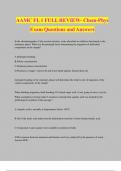
-
AAMC FL 1 FULL REVIEW- Chem-Phys Exam Questions and Answers
- Exam (elaborations) • 23 pages • 2024
-
- $13.49
- + learn more
AAMC FL 1 FULL REVIEW- Chem-Phys Exam Questions and Answers In the chromatography of the reaction mixture, water absorbed on cellulose functioned as the stationary phase. What was the principal factor determining the migration of individual components in the sample? A.Hydrogen bonding B.Solute concentration C.Stationary phase concentration D.Thickness of paper -Answer-B and D are dumb options. Knock them out. hydrogen bonding to the stationary phase will determine the relative rate of m...
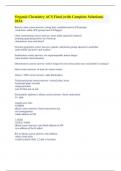
-
Organic Chemistry ACS Final (with Complete Solutions) 2024.
- Exam (elaborations) • 5 pages • 2023
- Available in package deal
-
- $10.99
- + learn more
Basicity rules correct answers -strong base: unstable/reactive (ED groups) -weak base: stable (EW groups/more EN/bigger) Chair conformation correct answers -more stable equitorial (slanted) -pointing up/pointing down=cis if both up -elimination: trans and diaxial Newman projection correct answers -gauche: substituent groups adjacent to eachother -grab middle and turn to put in plane Enantiomers correct answers -not superimposable mirror images -same besides stereochemistry Diast...
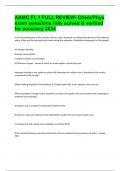
-
AAMC FL 1 FULL REVIEW- Chem/Phys exam questions fully solved & verified for accuracy 2024
- Exam (elaborations) • 24 pages • 2024
- Available in package deal
-
- $14.99
- + learn more
In the chromatography of the reaction mixture, water absorbed on cellulose functioned as the stationary phase. What was the principal factor determining the migration of individual components in the sample? A.Hydrogen bonding B.Solute concentration C.Stationary phase concentration D.Thickness of paper B and D are dumb options. Knock them out. hydrogen bonding to the stationary phase will determine the relative rate of migration of the various components in the sample. When thinking ...
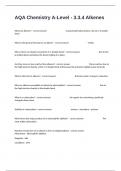
-
AQA Chemistry A-Level - 3.3.4 Alkenes Exam Study Verified Accurate Answers.
- Exam (elaborations) • 2 pages • 2024
- Available in package deal
-
- $12.99
- + learn more
What are alkenes? - correct answer Unsaturated hydrocarbons, due to C=C double bond What is the general formula for an alkene? - correct answer CnH2n Why is there no rotation around the C=C double bond? - correct answer Due to the pi orbital above and below the bond, holding it in place. Are they more or less reactive than alkanes? - correct answer ...

-
Chem 210 Exam 4 Questions and 100% Correct Solutions| Graded A+
- Exam (elaborations) • 4 pages • 2023
- Available in package deal
-
- $9.99
- + learn more
enantiomers are formed from __________ carbocation - achiral __________ are formed from chiral carbocation - enantiomers grignard reagents attack (most/least?) substituted epoxide? - least grignard reagents are used for (carbanion/carbocation?) generation. - carbanion we wat to use grignard reagents in (acidic/non-acidic?) conditions. - non-acidic if acidic conditions, it will suffer proton transfer hyperconjugation is (de/stabilizing?) for carbanions. - desta...

Do you wonder why so many students wear nice clothes, have money to spare and enjoy tons of free time? Well, they sell on Stuvia! Imagine your study notes being downloaded a dozen times for $15 each. Every. Single. Day. Discover all about earning on Stuvia


